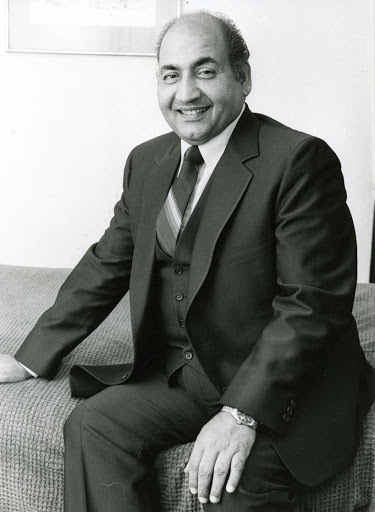Some of Rafi saheb’s finest renditions were for Naushad and S D Burman; both of whom are considered hindi cinema legends themselves. However what stands out is the contrast in styles between these two maestros – while Naushad excelled in compositions based on classical raagas; elder Burman was much more versatile.

Rafi with Naushad
Naushad gave Rafi saheb some of his best songs, some eternal compositions. Naushad was known for his raaga based compositions and his first choice male playback was Rafi. It would not be wrong to say that it is Naushad who is responsible for giving some great songs to Rafi early on in his career. These could well be considered as the songs which changed Rafi’s fortunes and established him as the leading playback singer which he remained for almost three decades. Although Rafi started as a chorus singer with Naushad; he got his solo break with “Tera Khilona Toota Baalak” for Anmol Ghadi (1946).
Naushad would often compose songs inspired in the higher octaves and knew that Rafi would do justice to these compositions. It is said that Rafi had a range of about three and a half octaves and it is this feature of his voice that was shown to the world.
Naushad used Bhairavi raag for the songs “Insaf ka mandir” – Amar , “Tu ganga ki mauj” – Baijubawra and “Yeh zindagi ki mele” – Mela.All the songs of the 1952 film BaijuBawra starring Bharat Bhushan and Meena Kumari were super hit.The Darbari Kanada was used for “Gujre hai aaj ishk mein” – Dil diya dard liya; “O duniya ki rakhwale” – Baijubawra and “Yaad mein teri jag jag”- Mere mehboob.In BaijuBawra , Naushad also composed the song “Door koi gaaye” in raag Desh and was sung by shamshad begum, Lata and Rafi.
Some other songs from Baijubawra were “Mann tarpat hari darshan” in raag Malkauns , “Jhule Mein Pavan Ke Aayi Bahar” in Pilu raag and “Insan Bano” in raag Todi.Raag Tilang was used in “Meri Kahani Bhulnevale” from the film Deedar in which a young Dilip Kumar is trying to rekindle lost love in the graceful Nargis.Yet another Yousuf Khan song and Rafi excelled in “Madhuban Men Radhika Nache Re” from Kohinoor based on raag Hamir.
Some more of Rafi’s vintage renditions for Naushad were “Koi sagar dil ko” from Dil diya dard liya in shubha kalyan ; “Mere mehboob tujhe” from mere mehboob in raag Jhinjhoti.” Ek Shahenshah Ne Banvaa Ke Hasin Tajmahal” in raag Lalit from the film Leader, ” Kal raat zindagi se mulaqat” in raag Mand from the film Palki, “Aaj Ki Raat Mere Dil Ki Salami Le Le” from Ram aur Shyam and “Suhani Raat Dhal Chuki” from Dulari both in raag Pahadi.Also , “dilruba maine tere” from dil diya dard liya and “tere husn ki” from Leader in raag Yaman Kalyan.
In one the interviews Rafi saheb had given in the late seventies, he has mentioned “Suhani Raat Dhal Chuki” as his favourite song.
Rafi with S D Burman
Rafi’s combination with SD Burman was brilliant to say the least. Burman da gave Rafi some of the most precious gems from his collection. Unlike Naushad, Burman Da did not ask Rafi to sing in the higher octaves…he had seen a different facet of Rafi’s voice. Many great gems from the SD – Rafi combination were sung in the middle octaves, some very gentle and soul touching songs which never needed to reach the higher octaves to generate the desired passion. This style of S D Burman could well be due to the fact that he was a student of Bengali folk and light classical music and this influence can be seen I his work over the years.
Pyaasa (1957) displayed the versatility of S D Burman’s music as well as Rafi’s singing with songs like “Ham Aapki Aankhon Me” , “Sar Jo Tera Chakraye”, “Ye Duniya Agar Mil Bhi Jaye”, “Ye Hanste Huye Phool”, “Jinhen Naaz Hai Hind Par” and “Tang Aa Chuke Hain Kashm-e-Kashe Zindagi”.The very next year SD Rafi partnership again created magic with Kalapani (1958) with songs like “Achcha ji main haari chalo maan jaao na” , “Dilwaale ab teri gali taq aa pahunche” and “Hum bekhudi mein tumko pukaare chale gaye”. Kagaz ke phool (1959); considered a commercial failure is still considered a classic and also remembered for its songs like “Bichre sabhi, bari bari”.The Raj Khosla directed Bombai ka babu (1960) featured hits like “Deewaana Mastaana Hua Dil” and “Saathi Na Koyi Manzil”.
In Meri Surat Teri Aankhen (1963), Burman Da gave the song “Pucho na kaise maine” to Manna de – who came up with a superb rendition of this semi classical master piece. However the same film saw Rafi come up with a definitive performance in “Tere bin sune”. The same year witnessed more magic with Tere Ghar ke saamne and songs like “Dil ka bhawar kare pukar”,”Tu kahan yeh bata” and “Tere gharke saamne”.
Guide – 1965, saw Burman Da again giving some very soft compositions in the voice of Rafi in the form of “Tere mere sapne”, “Din Dhal Jaye” and “Kya se kya ho gaya”.This was followed up with the “Aise to na dekho” and “Kahin bekhayal hokar” from Teen Deviyan.
There are a lot of other songs from SD Rafi combination that come to our mind like “Palkon ke peeche se” from Talash and “Teri Bindiya Re” from Abhiman (1973).Even Jaidev, who had been S D Burman’s assistant, used the same style by composing “Kabhi khud pe” and “Main zindagi ka saath” in Hum Dono; which were of course sung brilliantly by Rafi saheb.
Naushad and S D Burman composed in their own unique styles and both left behind some immortal compositions in the voice of the one and only – Mohammed Rafi.
